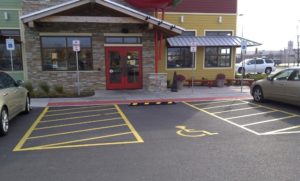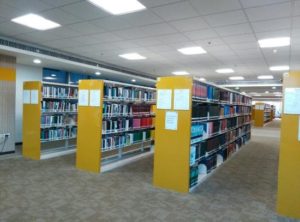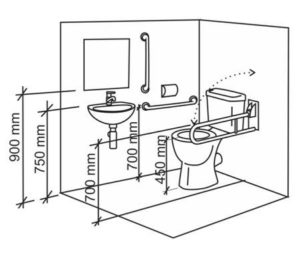
Source: https://in.pinterest.com/explore/importance-of-library/?lp=true
Limiting such places of idea germination to people with disabilities because they are not accessible is hence disabling the society from evolving to a better society.
In many countries all over the world, access for patrons with disabilities to use libraries is not yet available. In order to provide equal opportunities for all library users, it is necessary to look with the eyes of these patron groups at the physical condition of library buildings. Let us try to understand some of the necessary features to make libarries accessible.
PHYSICAL ACCESS:
The surroundings of the library, the entrance, restrooms, stairs, elevators and special rooms should be accessible for persons with different kinds of disabilities. A person in a wheelchair should be able to reach all departments, a visually impaired person should be able to walk with a cane or a guide dog and find his/her way without bumping into obstacles. A deaf person should be able to communicate with library staff. A person with an intellectual impairment should be able to easily find books and other materials.

Source: http://accessadvocates.com/ada-compliance-library/
a. Outside the library:
People with disabilities should be able to arrive at the site, approach the library building and enter the building easily and safely. If the main entrance cannot be made accessible, a secondary accessible entrance should be provided. Some other necessary arrangement are:
- Sufficient parking spaces marked with the international symbol for the disabled
- Parking close to the library entrance
- Clear and easy to read signposting
- Unobstructed and well lighted access paths to the entrance
- Smooth and non-slip surface at the entrance

https://gaates.org/DOPS/p_2_6_1n1.php
b. Getting into the library:
A person in a wheelchair or blind person or a walker should be able to enter through the door and pass through security check points. To ensure this:
- Sufficient space in front of the door to allow a wheelchair to turn around
- Automatic door opener reachable by a person in a wheelchair
- No doorsteps — for easy wheelchair access
- Glass doors marked to warn visually impaired persons
- Security checkpoints possible to pass through with a wheelchair/walker or other mobility aides
- Stairs and steps marked with a contrasting color
- Pictogram signs leading to elevators
- Well lighted elevators with buttons and signs in Braille
- Elevator buttons reachable from a wheelchair

Source: https://larsandersenassociates.wordpress.com/2011/02/14/accessible-doors-and-entrances/
2. ACCESS TO MATERIALS AND SERVICES:
All parts of the library should be accessible. The space should be logically arranged with clear signs and a floor plan posted close to the entrance. Service desks should be located close to the entrance. Wheelchairs should be able to move around inside the whole library. There should be a lift for wheelchairs or a ramp, if the library has more than one level. Ideally, shelves should be reachable from a wheelchair. A certain number of tables and computer workstations should be adapted for persons in wheelchairs and at least one toilet for disabled persons.
a. Physical Space
- Shelves reachable from a wheelchair
- Reading and computer tables of varying heights throughout the library
- Chairs with sturdy armrests
- Unobstructed aisles between bookcases
- Visible and audible fire alarm
- Staff trained to assist patrons in case of emergency

b. Circulation desk:
- Adjustable desk
- Induction loop system for hearing impaired persons
- Chairs for elderly and disabled customers
- Accessible self-service circulation stations

c. Children’s department:
- Clear signs with pictograms leading to children’s department
- A colored (yellow for visibility) tactile line leading to the children’s department
- Unobstructed aisles between shelves
- Computers accessible for children with disabilities

https://libwww.freelibrary.org/locations/departments/childrens-department
d. Toilets:
- Clear signs with pictogram indicating the location of the toilets
- Door wide enough for a wheelchair to enter and sufficient space for a wheelchair to turn around
- Toilet with handles and flushing lever reachable for persons in wheelchairs
- Alarm button reachable for persons in a wheelchairs
- Washbasin, mirror at the appropriate height

Source: http://wapenang.blogspot.in/2012/03/how-to-design-toilet-wc-for-disabled.html
3. PROVIDE INFORMATION TO PATRONS WITH DISABILITIES:
a. Visually impaired persons:
- Information in large print
- Information on audio tape, CD/DVD, or in DAISY format
- Information in Braille
- Information on the library’s accessible website.

http://www.allaboutvision.com/buysmart/magnifiers.htm
b. Deaf or hearing impaired persons:
- Information in subtitled and sign language videos
- Information via text and email
- Information on the library’s accessible website (audio information should also be available as text)
c. Persons with reading difficulties:
- Information written in an easy-to-read text
- Information on audio/video tape, CD/DVD, or in Daisy format
- Information on the library’s accessible website

https://playingwithsid.blogspot.in/2010/07/nepal-national-audio-library-for-blind_07.html
d. Persons with physical disabilities:
- Information on audio/video tape or on CD/DVD or in DAISY format
- Information on accessible website

http://www.dlf-data.org.uk/products.php?groupid=2430&showarchive=true
